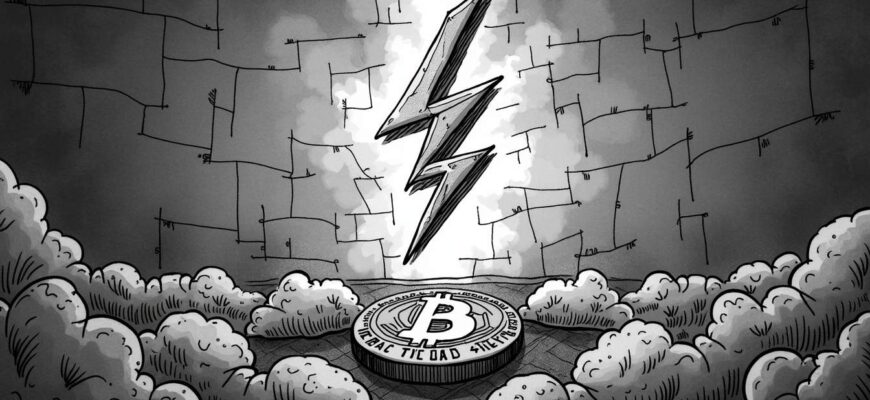Tether’s stablecoin, USDT, is merging with Bitcoin’s Lightning Network, which could change the way we think about finance. With the promise of faster transactions, lower costs, and wider reach, this move could take a toll on traditional banking systems. But as USDT takes this leap, the shadows of transparency and regulation loom large. Could this speed-and-stability alliance change the face of global finance? Let’s unpack this partnership and its implications for decentralized finance.
Understanding USDT and Bitcoin’s Lightning Network
USDT, boasting the title of the world’s largest stablecoin with a valuation around $140 billion, is about to become fully functional across Bitcoin’s core and Lightning Network. Tether CEO Paolo Ardoino made the announcement at the Plan B conference in El Salvador, emphasizing practical applications for remittances, payments, and financial transactions that need speed without sacrificing reliability.
Bitcoin has had a hard time pulling in on-chain users, mainly because it wasn’t designed for decentralized applications. The Lightning Network, a second layer for scaling, changes the game by allowing rapid and inexpensive transactions, thus making it possible for assets like USDT to join Bitcoin’s broader ecosystem.
Potential Impact on Traditional Banking
Integrating USDT with Bitcoin’s Lightning Network could disrupt the traditional banking landscape. The Lightning Network’s capability to handle millions of transactions per second dwarfs that of traditional banks and even Bitcoin’s own blockchain, which manages only 5-7 transactions per second. This level of scalability and near-instant transaction times may make digital payments more efficient and a real contender against conventional payment systems, such as Visa, which processes over 20,000 transactions per second.
Scalability and Speed: A New Frontier
The scalability and speed provided by the Lightning Network could be a game changer. With this tech backing it, USDT transactions could go through almost instantly, making digital currencies more viable for everyday transactions. This could lead to significant adoption of cryptocurrencies in everyday commerce and pose a challenge to the supremacy of traditional payment methods.
Cost Savings and Cross-Border Payments
A major benefit of this integration is the drop in transaction costs. Traditional banking systems and even Bitcoin transactions can rack up steep fees, particularly for cross-border payments. The Lightning Network, by contrast, offers much lower fees, making it an appealing choice for global remittances and microtransactions. This cost efficiency, paired with instant settlement, could revolutionize cross-border transactions and merchant acceptance.
Opening Up New Avenues and Accessibility
The merger of USDT and the Lightning Network opens doors for over 350 million Tether users globally, allowing payments via the existing Lightning infrastructure. This could extend digital payments into emerging markets, where stablecoins might serve as a buffer against local currency depreciation. Plus, this integration invites new use cases like AI-driven transactions, DeFi growth, and machine-to-machine payments, potentially disrupting traditional banking by enabling fresh financial products.
Transparency Concerns and Regulatory Hurdles
As Tether’s footprint grows in the global economy, so does the scrutiny it faces. Regulators have raised red flags regarding the transparency and backing of Tether’s reserves. The absence of independent collateral verification for USDT raises serious concerns about the stability and credibility of the stablecoin market. Tether’s reserves are partially made up of risky and illiquid assets, raising the specter of losses and liquidity crunches. The process to redeem USDT is also limited and conditional, adding more uncertainty.
Moreover, Tether is not immune to legal and operational risks, including regulatory probes and possible prohibition orders from U.S. authorities. The opaque and unverifiable nature of its collateral increases the likelihood of a run on USDT, which could destabilize other financial markets. Compliance and investigation risks hang in the air, with Tether facing scrutiny for various compliance issues.
Final Thoughts: The Future of Stablecoins and DeFi
The merging of USDT with Bitcoin’s Lightning Network could redefine the landscape of decentralized finance. By enhancing scalability, fostering adoption, bridging traditional finance, promoting financial inclusion, and pushing technological innovation, this partnership could pave the way for a more decentralized and efficient financial system. Yet, the regulatory and transparency hurdles surrounding Tether must be addressed to maintain trust in the stablecoin market.
The unification of USDT and Bitcoin’s Lightning Network may offer a new frontier for the financial industry, challenging the norms of traditional banking and ushering in a new era of stablecoin and blockchain technology.








